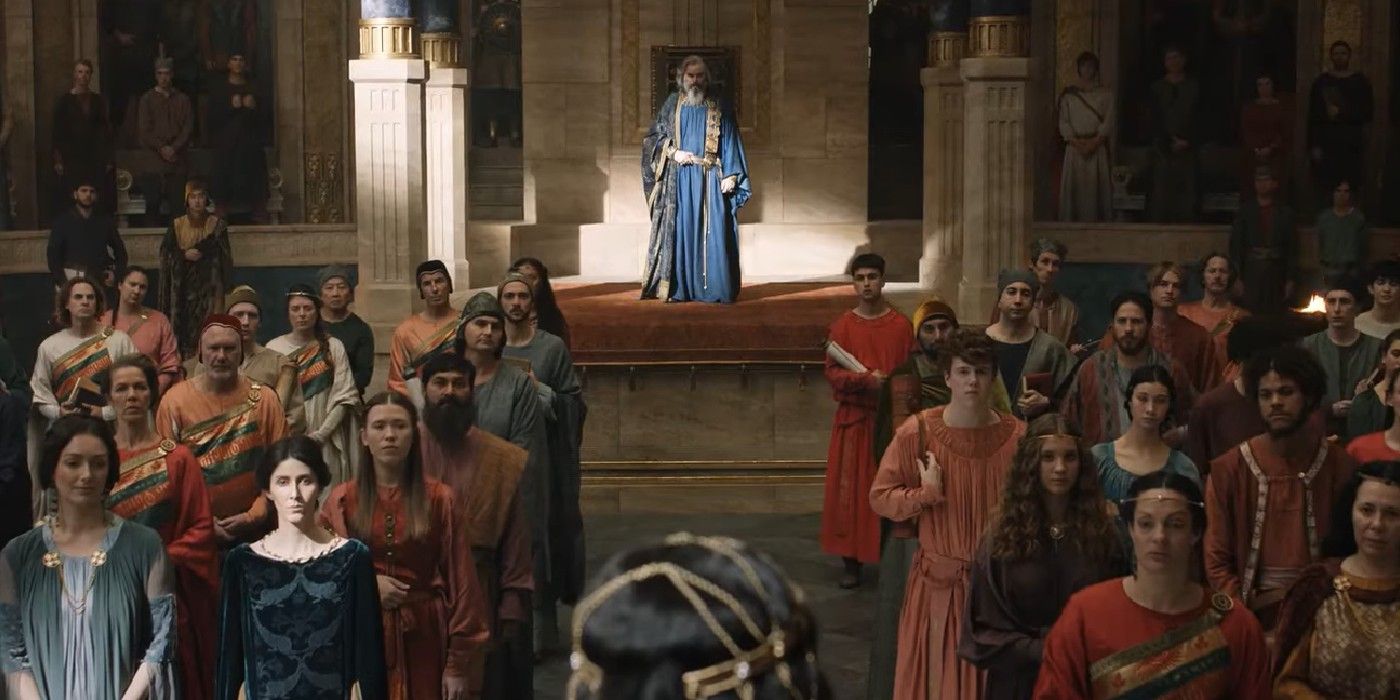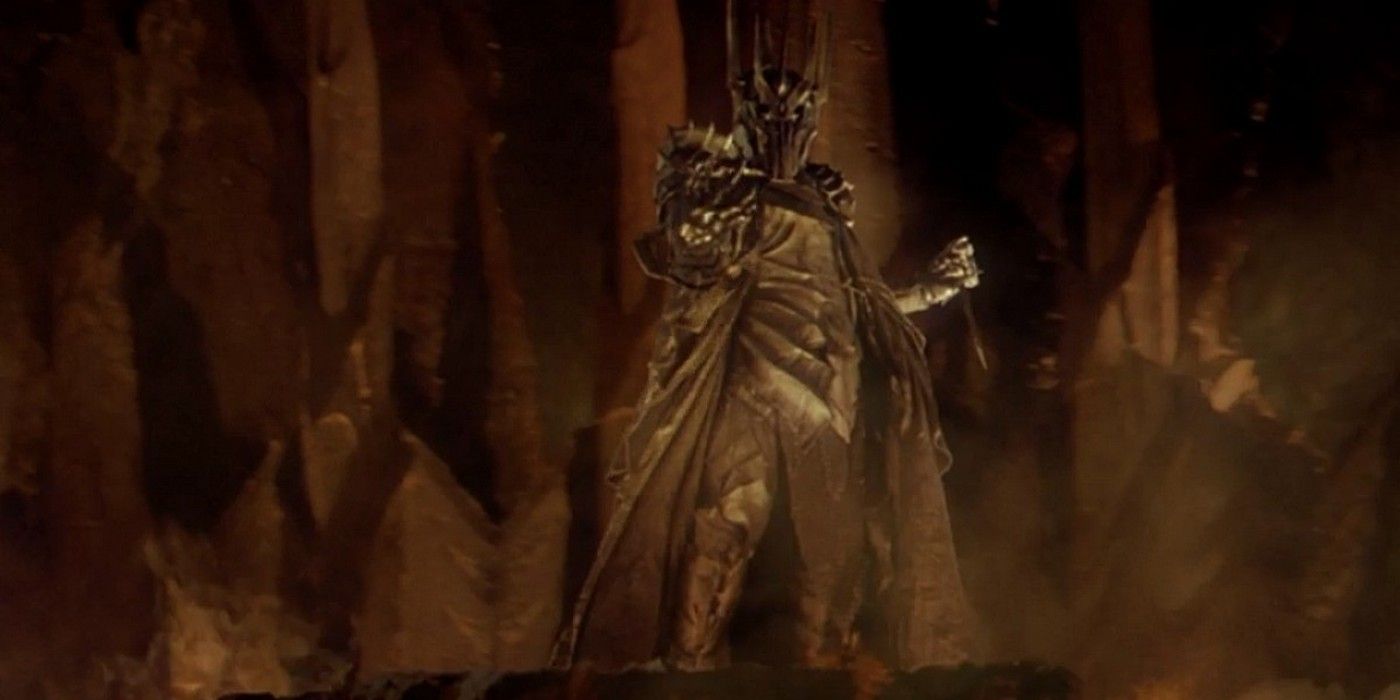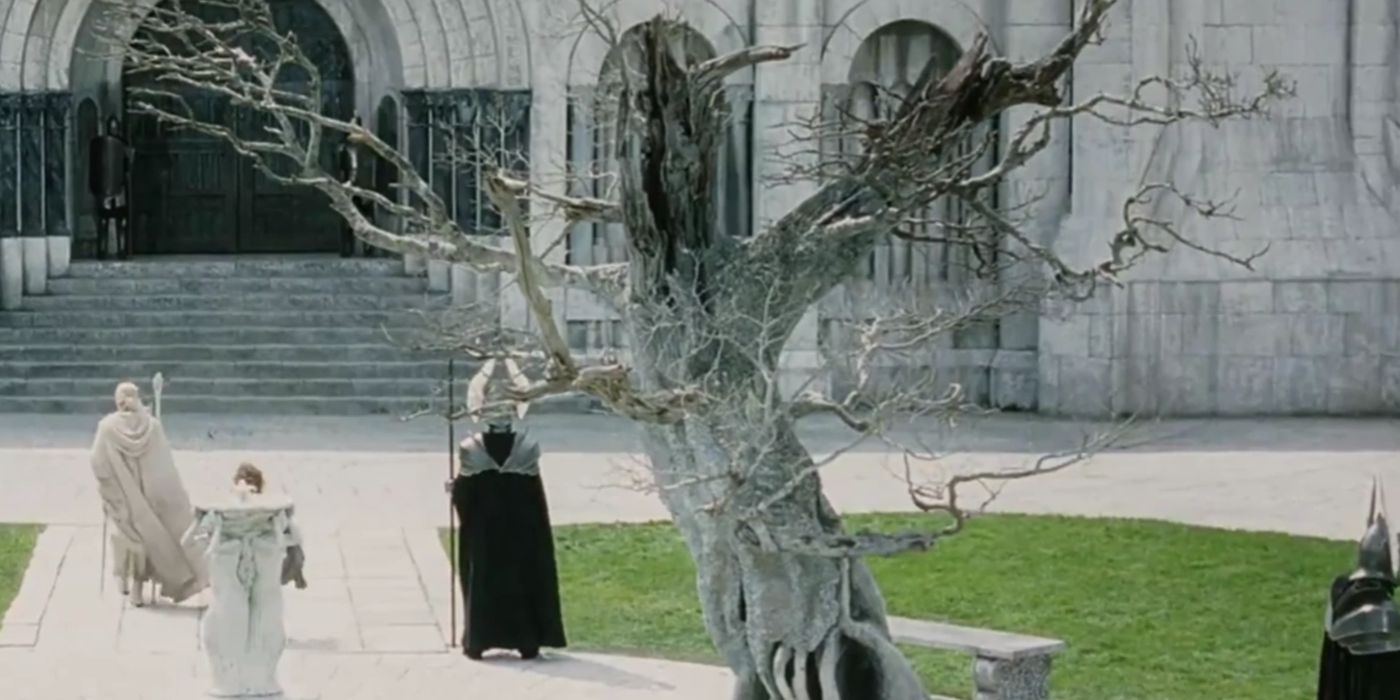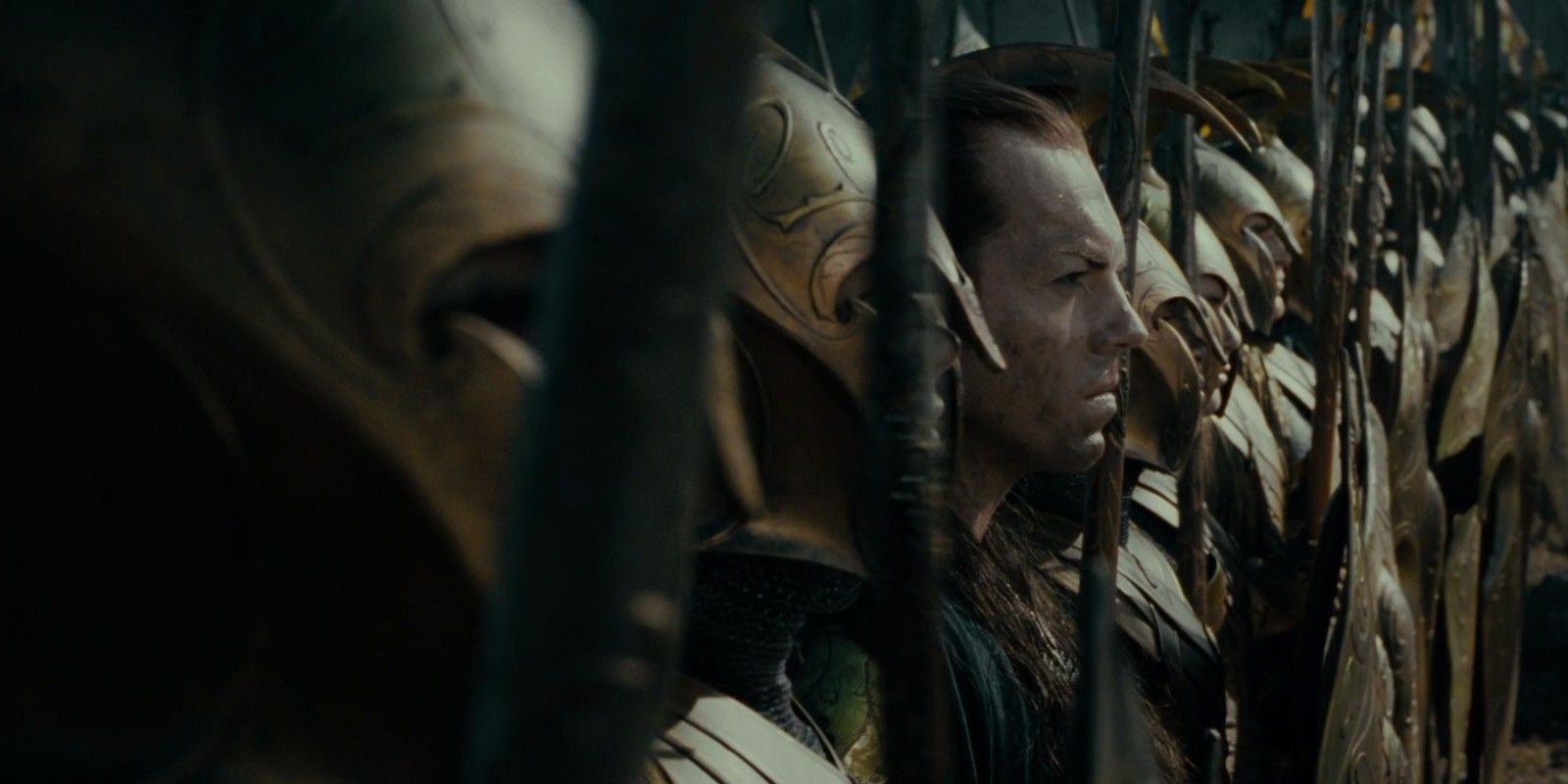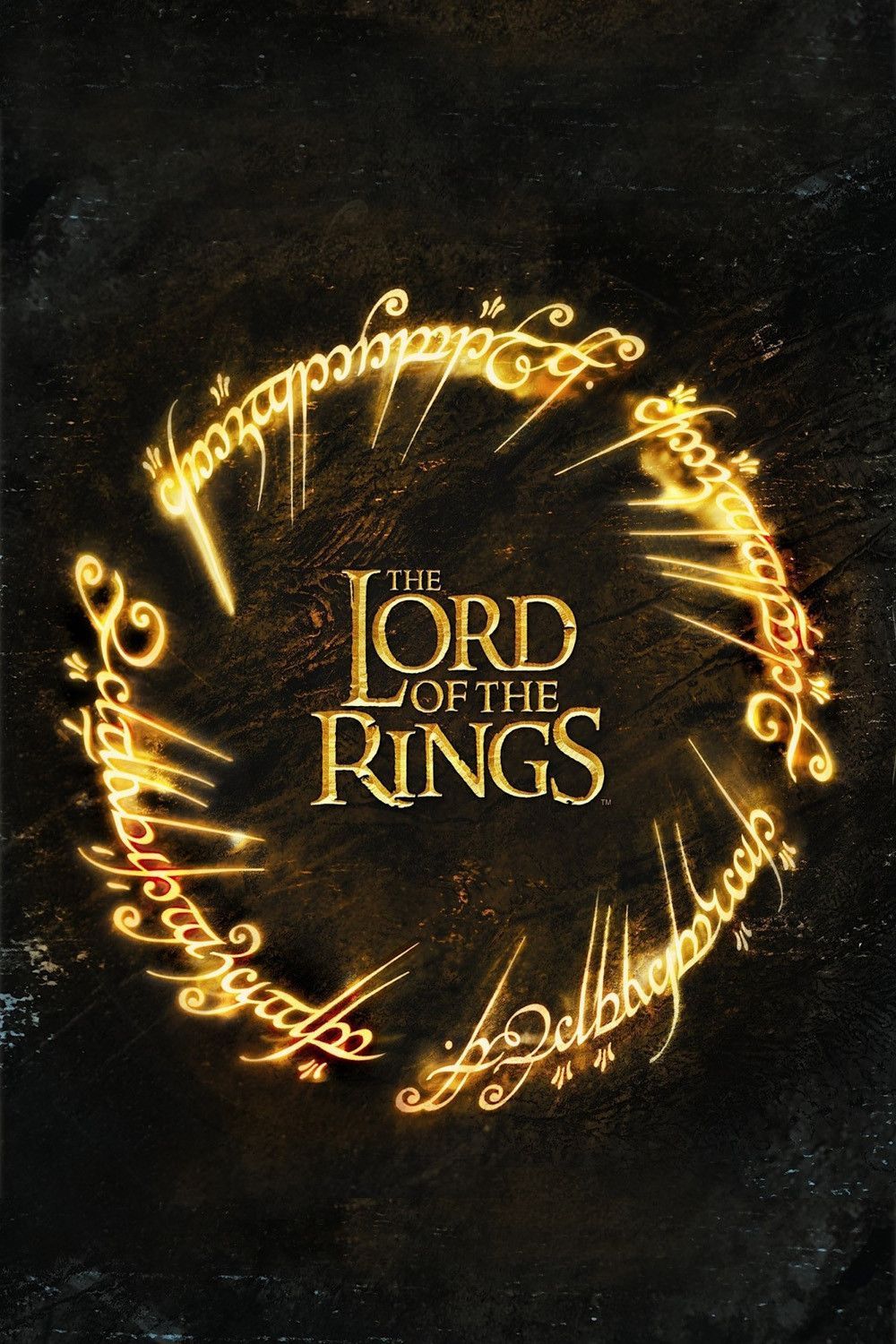Summary
- The Second Age of Tolkien’s world is rich with epic events, setting the stage for the iconic Lord of the Rings stories.
- Númenor’s downfall, the creation of the Rings of Power, and the Last Alliance are key moments of the Second Age explored in detail.
- Amazon’s The Rings of Power series delves into the intricate history of Middle-earth, bridging the Second and Third Ages in a compelling narrative.
This article contains spoilers for The Lord of the Rings: The Rings of Power.J.R.R. Tolkien’s Second Age is just as intense and influential as The Lord of the Rings‘ era, constituting many major events and developments. So vast is Tolkien’s fictional mythology, that the timeline of Eä (the universe in which Middle-earth exists) is split into ages, some of which span several millennia. Following the outset of creation, the exceptionally long Years of the Valar and the Years of the Trees passed. The First Age began after Morgoth cruelly destroyed the Two Trees of Valinor, followed by the Second, Third, and Fourth Ages, which is where Tolkien’s Lord of the Rings timeline ends.
For reference, The Hobbit and The Lord of the Rings both take place around 3000 years into the Third Age, and it’s Aragorn’s coronation in The Return of the King that officially cuts the ribbon on the Fourth. Although Tolkien’s most famous stories both happen within a single century, the author wrote plenty on what came beforehand, with appendices, The Silmarillion, and other works extensively detailing everything from the moment Eru Ilúvatar and his band sang the world into existence to the day Bilbo Baggins left the Shire with a bunch of Dwarves and a wizard.
The Second Age’s Landscape Explained
The War of Wrath Ended The First Age
Despite the Third Age’s tales taking pride of place on bookshelves and in movie theaters, the rest of Tolkien’s timeline is no less epic or important. Indeed, the Second Age is arguably more seismic than its successor, and this is where Amazon’s The Lord of the Rings: The Rings of Power pulls its inspiration from. The 3441 years that comprise J.R.R. Tolkien’s Second Age can be explained through documentation of all its key moments.
The First Age ended with the War of Wrath, where Morgoth tasted defeat courtesy of a mighty host from Valinor, and with darkness finally lifted, the Free Peoples could make their homes again. The Elves anointed Gil-Galad as High King of the Ñoldor, and Lindon became their main province, while Círdan oversaw the nearby Grey Havens where Elves would set sail for Valinor. As a reward for the Houses of Men who fought against Morgoth, the Valar raised an island between Middle-earth and Valinor. Here, the kingdom of Númenor was established, with Elrond’s brother Elros its first king.
Though Lindon would remain the hub of Elf activity during The Lord of the Rings‘ Second Age, pointy-eared folk spread east through the centuries. Eregion was established near the Misty Mountains, ruled over by Lord Celebrimbor, while Galadriel and her husband Celeborn would move to Lothlórien on the other side of the range. Men who served under Morgoth or didn’t join the War of Wrath remained in Middle-earth, mainly settled on the coasts and to the south, or remaining in Rhovanion and the Rhûn in the east. Pockets of Dwarves could be found spread around Middle-earth’s mountainous regions.
J.R.R. Tolkien wrote about the Second Age a lot in
The Silmarillion
, published posthumously in 1977.
This racial landscape is very different from The Lord of the Rings‘ Third Age, where the Elves were less prominent. In the Third Age, Men were on the rise, Hobbits had laid roots in Eriador’s Shire, and the Dwarves’ most famous, grandest halls had fallen to dragons, Balrogs, and greed. The Second Age reflected the glory of the Elves, marking out Tolkien’s Second Age stories with a particular grandiosity and nobility, contrasting the frequent humor brought by Hobbits to Third Age content in Lord of the Rings.
How The Second Age Sets Up Númenor’s Downfall
Númenor Fell In The Second Age
For around 2000 years, Númenor was a shining beacon of the greatness mortal civilization could achieve. The island kingdom prospered, grew, and evolved as one king after another continued the lineage of Elros, and in the Second Age’s sixth century, the Númenóreans’ aptitude for sailing allowed them to rediscover Middle-earth, the home of their ancestors.
Strong relations were forged between Númenor and Gil-Galad’s Elves, while the blessed Men shared their superior knowledge with “lesser” kin they encountered. Fleeting visits soon turned into permanent strongholds, giving Númenor a foothold in their motherland. Glad tidings indeed, but Númenor’s presence in Middle-earth brought the kingdom one step closer to doom.
Another crack emerged in the Númenórean foundations during this period. The first child of Númenor’s then-ruler was a girl named Silmariën, but deeply sexist kingdom rules forbade female succession, so the scepter passed onto her younger brother. Though the top job eluded her, Silmariën and her husband began a splinter line known as the Lords of Andúnië – effectively non-ruling descendants of Elros. Silmariën’s lineage would spawn Elendil, Isildur, and eventually, The Lord of the Rings‘ Aragorn.
Andúnië was named from an Elvish language called Quenya, in which
andúnë
meant ”
sunset
.”
As the centuries passed, Númenor’s ruling house and the Lords of Andúnië diverged massively in their philosophies. The king’s line became increasingly jealous of the Elves’ immortality and angry at the Valar for prohibiting them from sailing west toward Valinor. The third millennium of the Second Age saw Númenor gradually reject their old traditions and allegiances, forsaking Vala and Elf alike, and dominating the Men of Middle-earth rather than cooperating with them. The Lords of Andúnië, meanwhile, remained faithful to their roots and resisted temptations of power.
How The Rings Of Power Were Created (& What Happened Next)
Sauron Made Rings With Celebrimbor
Sauron’s Second Age rollercoaster makes his Lord of the Rings journey look relaxing by comparison (embarrassing defeat at the hands of Hobbits notwithstanding). When the First Age concluded, a weakened Sauron promptly hid in Middle-earth for the better part of five centuries, after which time his presence began to creep forth once more. Nevertheless, the Dark Lord retained a low profile until nearer year 1000 of the Second Age when he chose Mordor as a permanent home. Yet another 500 years would then pass while Sauron consolidated his power, transformed Mordor into a wicked wasteland, and formulated a cunning plan.
This cunning plan involved transforming into an alter ego called “Annatar,” who looked considerably less like a mythical tyrant hell-bent on taking over the world since Sauron still possessed the ability to shapeshift during the Second Age. Annatar approached the Elves promising knowledge and gifts, and while Gil-Galad, Elrond, and Galadriel were all deeply skeptical of this too-good-to-be-true stranger, Celebrimbor the Elven smith cautiously took Sauron into Eregion. With the magical knowledge of an evil Maia on their side, the Elves of Eregion constructed a series of 19 magic rings, only three of which Celebrimbor forged personally, without dark interference.
A wealth of information on the Rings of Power can be found in the fifth part of
The Silmarillion
, ”
Of the Rings of Power and the Third Age.
”
As The Fellowship of the Ring‘s history lesson details, Sauron sneaked off and constructed the One Ring, but played his hand far too early, and the Elves realized they had been duped. Sauron successfully swiped 16 of the rings he helped create, gifting nine to kings of Men and seven to Dwarf-lords. Sauron then executed his masterplan, but the Elves had already removed their three rings, while the Dwarves proved too hardy to corrupt. Only the Men fell under Sauron’s sway, transforming into the Nazgûl. Sauron, meanwhile, used the One Ring to finish construction on his Mordor fortress, Barad-dûr.
Sauron’s Middle-earth Rise, Fall, Rise, Fall, Rise & Fall
Sauron Often Had Power In Middle-Earth’s History
In the fallout of his One Ring betrayal, a seven-year war kicked off between Sauron and the Elves. For the most part, Sauron had the upper hand during this conflict, destroying Eregion completely, though Lindon held firm under siege, and Lothlórien remained protected by High-elf Galadriel. From the ashes of Eregion, Elrond established the land of Rivendell (of The Lord of the Rings fame), which also stood strong against assault from Sauron’s forces. The war’s tide finally turned when reinforcements arrived from Númenor. With Elves and Men combining forces, Sauron was sent back to Mordor, tail between black-armored legs.
Middle-earth’s dark shadow wouldn’t rise again for around 1500 years. Sauron spent that time readying another campaign for conquest, and by the time his machinations were ready, Númenor was no longer the heroic race of yore, having fallen under a dark shadow of its own. In his arrogance, however, Númenor’s ruler, Ar-Pharazôn, took exception to Sauron declaring himself “King of Men,” since the islanders had come to believe they deserved that lofty honor. Once again, Númenóreans sailed for Middle-earth, but this time they took their enemy prisoner, dragging Sauron back to their star-shaped island in a deeply regretful crossroads moment.
Sauron ultimately convinced Ar-Pharazôn to launch an assault upon Valinor, which is like convincing a child to fire their water pistol at a tank.
Over the next 50 years, Sauron climbed the ladder of opportunity from Númenor’s prisoner to the closest advisor of Ar-Pharazôn, taking advantage of the aforementioned divisions and nurturing the ruling house’s hatred of the Valar. Sauron ultimately convinced Ar-Pharazôn to launch an assault upon Valinor, which is like convincing a child to fire their water pistol at a tank. Ar-Pharazôn’s forces were either wiped out in the sea, or on the shores of Valinor, while Númenor itself got cast into the watery depths. Sauron survived the divine assault, but was stripped of his transformative ability.
How Gondor Was Founded (& What Happened To Arnor)
Elendil Escaped The Fall Of Númenór
Not every Númenórean died the day Eru Ilúvatar’s wrath redrew the landscape of the Sundering Seas. Some from the Lords of Andúnië and elsewhere who remained faithful to Númenor’s original ideals were spared the cataclysm, allowed to escape the destruction on a small fleet of ships and arrive back in Middle-earth safely. Most importantly for The Lord of the Rings, these refugees included Elendil and his two sons, Isildur and Anárion.
Upon reaching land, Elendil claimed kingship over the Men of Middle-earth (except those who had already turned toward darkness, such as the Black Númenóreans and the Easterlings). Alongside his sons, Elendil established two great kingdoms – Gondor and Arnor – styled in the spirit of Númenor. Gondor’s checkered history and dogged survival is chronicled in The Lord of the Rings. Arnor, meanwhile, has already long fallen by the time Frodo sets out from the Shire. Suffering a gradual decline throughout the early Third Age thanks to infighting and loss of relevance, Arnor was finally toppled by the Witch-king of Angmar.
The Last Alliance Of Elves & Men (& Why It Didn’t Last)
The Second Age Ended With The Last Alliance
The Lord of the Rings‘ Second Age ended with one final battle pitting Sauron’s collected forces against the assembled forces of Gil-Galad, Elendil, and select groups of Dwarves (most likely from Khazad-dûm). Losses were heavy on both sides, with Gondor losing its original capital of Osgiliath. Unity eventually won out and, as recounted in The Fellowship of the Ring, the Last Alliance pushed Sauron back to Barad-dûr, besieging the fortress completely. Gil-Galad and Elendil personally battled Sauron, and though both died in the process, the Dark Lord was weakened enough for Isildur to cut the One Ring free.
Victorious though the Last Alliance might’ve been, the good guys never
truly
recovered.
This victory reduced Sauron to a whisper of his full glory for the next 3000 years and ended the Second Age. Victorious though the Last Alliance might’ve been, the good guys never truly recovered. Losing Gil-Galad ended the Elves’ line of High Kings, and the coastal Lindon was diminished after the Númenor incident. As seen in The Lord of the Rings, more Elves would migrate west toward Valinor thereafter. True to form, Men would mastermind their own problems as the Third Age began. Gondor was weakened, Arnor was defeated, and one true king was needed to bring Middle-earth’s mortals together.
When In The Second Age The Rings Of Power Season 2 Is Set
The Rings Of Power Will Extend To The Third Age
The Rings of Power season 2 is set roughly halfway through the Second Age, but The Lord of the Rings timeline will reach the end of the Second Age by the end of the show’s final season. The show started with a flashback from Galadriel’s perspective which showed the Years of the Trees and some events of the First Age, culminating in the present-day setting of The Rings of Power in the Second Age on an unknown date. However, the year of the Second Age that the show is set in in its first and second seasons can be guessed.
Showrunner interviews and trailers for The Rings of Power season 2 confirmed the rough storyline that it will follow. Sauron will take his fair form and return to Eregion, where he will forge the Rings of Power with Celebrimbor. Celebrimbor will turn from Sauron eventually and Sauron will launch his War against the Elves, carrying out the siege of Eregion. Tolkien provided a timeline for the Second Age, which events of The Rings of Power can be traced back to in order to confirm its timing.
|
Second Age Event |
Second Age Year |
|---|---|
|
Sauron began construction on Barad-dûr |
1000 |
|
Sauron befriended the Elves of Eregion as Annatar |
1200 |
|
Rings of Power were forged |
1500 |
|
The Three great Elven Rings were forged |
1590 |
|
The One Ring was forged, Barad-dûr was completed, Sauron openly proclaimed himself |
1600 |
|
Sauron began to prepare to invade Eriador |
1605 |
|
The War of the Elves and Sauron began |
1693 |
|
Sauron invaded Eriador |
1695 |
|
Sauron sacked Eregion and killed Celebrimbor. Rivendell was founded. The Dwarves assailed Sauron. Khazad-dûm closed. |
1697 |
|
Sauron overran Eriador |
1699 |
|
Númenóreans defeated Sauron |
1700 |
|
Sauron was driven from Eriador and fled to Mordor. First White Council held. |
1701 |
The timeline in the show will not follow the canonical timeline exactly. Doing so would involve somehow convincingly displaying the passage of time over centuries, aging characters and settings, and eradicating the pacing of action or adventure cinema. It seems like the events of The Rings of Power season 2 will take place at any point between Second Age 1100 and 1701. This 601-year timeframe will likely be compressed significantly, like some of the events of season 1. The events of Rings of Power season 1 would have taken place in the lead-up to 1100.



